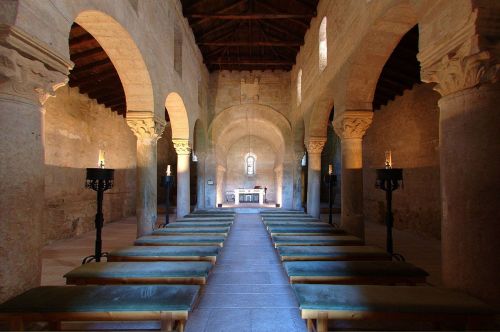#visigothic
San Juan Bautista (akaSan Juan de Baños), Baños de Cerrato, Palencia, central Spain
Built in 661 AD under the commission of the Visigothic king Recceswinth (Spanish: Recesvinto), this is the only Visigothic church building that can be dated with certainty. The king is said to have built the church out of gratitude for his recovery from a kidney disease, which he attributed to the healing powers of the local spring water.
The spring (Fuente de San Juan, or also Fuente de Recesvinto) is on the opposite side of the road, south of the church. It has been known as a healing spring since antiquity. In Roman times there was a temple of Asclepius here, and an altar for the nymphs.
Photo (1) shows Recceswinth’s crown displayed in the church (which is actually a copy; the original crown is preserved in Museo Arqueológico Nacional, Madrid).
Excavations carried out north-east of the church between 1956 and 1963 discovered a graveyard with 58 graves, as well as three objects from the 7th century: two bronze fibulae in the shape of a lyre and the handle of a liturgical vessel.
Over the centuries of its existence, the church has undergone multiple renovations and restorations. A medieval renovation altered the layout of the building as can be seen here. The belfry is an addition from a 19th century restoration.
The church was declared a national monument in 1897.
Sources (more to read and see): [1] [2] [3] [4] [5]
Post link


![esmitierra:Hermitage of Santo Cristo, Coruña del Conde, Burgos, Castile and León, Spain. VIA. [x] esmitierra:Hermitage of Santo Cristo, Coruña del Conde, Burgos, Castile and León, Spain. VIA. [x]](https://64.media.tumblr.com/35943198c599fcc0d476641f72105899/tumblr_oz02aaQfWI1tsl05ao1_500.jpg)




